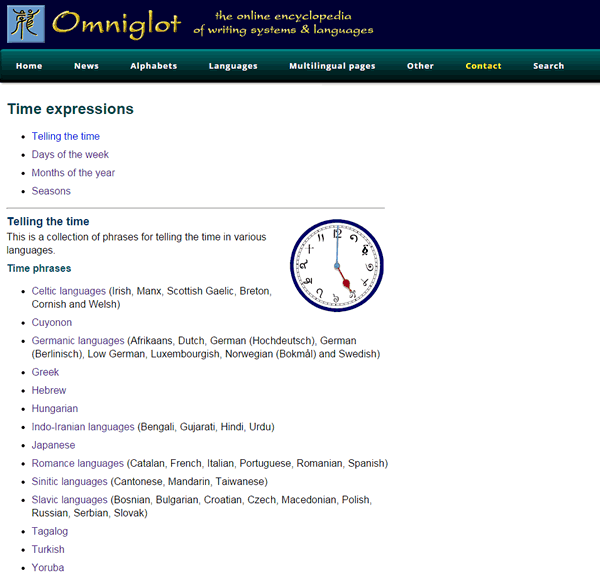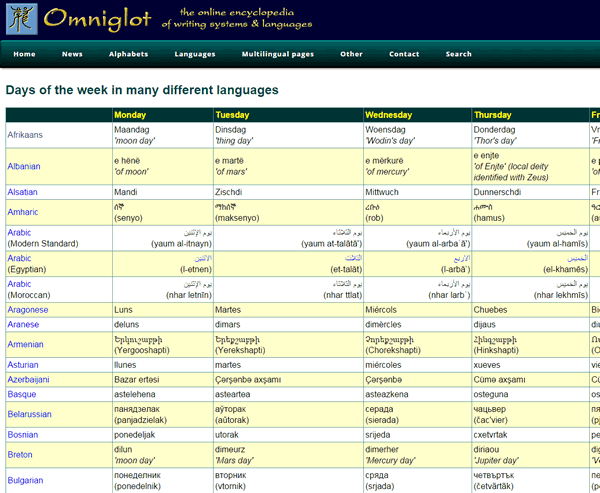This blog has been chosen as one of the Top 100 Language Learning Blogs – a list which includes links to other language-related blogs that might interest you.
Many thanks to those who chose this blog.
This blog has been chosen as one of the Top 100 Language Learning Blogs – a list which includes links to other language-related blogs that might interest you.
Many thanks to those who chose this blog.
When I meet people who are familiar with my website, some of them say how much they like my blog. When I ask them what they like about it, they mention things that are on my website, rather than on this blog, so I soon realise that they’re using the word blog to refer to my website, and possibly this blog, although not all of them are aware of the blog’s existence.
To me the distinction between my website and my blog(s) is clear. They may be on the same server, but they look different and have different functions. I’ve noticed that on some other websites though there isn’t such a clear distinction between blogs and other pages, especially on ones that have grown from blogs. Maybe that’s why people get confused.
Sometimes people tell me about mistakes on other sites which are linked to on Omniglot, thinking that I have something to do with them and can make changes on them. I understand why this happens as they might not realise that they’re on a different site.
None of these things are particularly important, but it’s interesting, to me at least, to notice them.
Is there a distinction between the words for website and blog in other languages?
There is a now a new way to view the phrases on Omniglot: a Phrase finder.
This page enables you to see phrases in any combination of two languages. This is something I’ve been planning to set up for years, and now it’s finally ready.
So if your native language isn’t English and you want to see phrases in your mother tongue and another language, you can.
If you want to see the similarities and differences between two closely related languages, you can.
If you want to see two completely different languages side by side, you can.
The phrases are stored in server-side includes and displayed on the page using PHP, which was written by David Stephens of LinguaShop.
The phrases are currently available in 233 languages. If you can provide phrases in other languages, or additional phrases for the existing languages, or recordings, please contact me.
A while ago I did a interview with Mango Languages in which I talk about Omniglot and how and why I learnt my languages. If you’re interested you can hear it here:
There’s a related blog post here: https://blog.mangolanguages.com/an-interview-with-the-omniglot
Apparently today is Finnish Language Day or Suomen kielen päivä. It is the anniversary of the death of Mikael Agricola (c. 1510-1557), a clergyman who is known as the “father of literary Finnish” – he translated religious works into Finnish, including the New Testament, and modern Finnish spelling is based on his work. Before then there was no standard form of written Finnish [source].
It is also my birthday – Ta mee shey bleeaney as daeed d’eash jiu.

Last week I went to a concert that featuring a jazz pianist and an artist. While the pianist played, the artist painted on her iPad, which was connected to a projector and projected on a big screen. The artist created pictures based on the music, and I think the pianist also created some tunes based on the art. It was all very abstract, especially the art. During the concert I was looking for patterns, shapes or anything in the art that looked like something familiar. I didn’t find much, but enjoyed the experience anyway.
Afterwards I got thinking about patterns and familiarity and came to the conclusion that we tend to feel most comfortable with the familiar – familiar people, things, places, sounds, etc – i.e our comfort zone. When we encounter the unfamiliar we try to find anything in it we can make sense of. We look for patterns, and anything else we can recognise. If we cannot find such things we may decide that the unfamiliar is not for us.
Abstract art and some forms of music, for example, are sometimes said to be “challenging”, and I think this is because there is little in them that is familiar, and this is why it takes longer to appreciate them – we need longer to find any patterns they may contain and for them to become familiar.
When we first encounter a foreign language everything is unfamiliar, and this can put a lot of people off. However a language that has a lot in common with your mother tongue can be easier to learn than one that has little or nothing in common with it as you will find more that is already familiar, and probably feel more comfortable with it.
To become familiar with the patterns, sounds, words and structures of a foreign language we need to get a lot of exposure to it – i.e. listen, read, and watch films and TV programmes. Doing these things alone is not enough to learn a language – you need to speak it and maybe write it as well – but they will make it more familiar to you.
The more you learn of a language, the more patterns you will spot within it, and the easier it will be to spot those patterns. The patterns might be how words are put together to form sentences, how grammatical changes are applied to words, how words can mean different things in different contexts, how speakers interact with one another, what topics are appropriate to different situations, and so on.
So you may need to get outside your comfort zone at first, but over time your comfort zone will expand to include the new language.
I think I’ve managed to make Omniglot work better on mobiles and other devices with small screens now. I know that the homepage goes a bit strange in IE when you make your browser narrow (not sure how to fix that), and there may be some other elements that are not behaving themselves, but it seems to be generally okay in the tests I’ve run on different screen sizes and devices. If you spot anything that isn’t working, please let me know. If you can suggest solutions, even better.
My redesign of Omniglot is now complete, except for the homepage. All inner pages are now aligned to the left, and have drop-down menus at the top, which should make it easier to find your way around, and should work well on all sizes of screen. Initially I tried to keep the central alignment, but couldn’t work out how to centre the menu, so gave up on that. Then I realised that the left alignment gives more flexibility, which is one of the goals of the new design. I’ve also finally finished converting the whole site to HTML5 – this doesn’t change the look of it, but does make managing it easier, and streamlines the code.
I have been working on a new homepage and am trying to come up with a fluid design that works well on all screen sizes. You can see what I’ve done so far here – this page is changes frequently as I try out different layouts and adjust the contents and images.
Does the new design work for you?
Have you spotted anything that could be improved?
What do you think should appear on the homepage?
Recently I have been working on a new design for Omniglot which should be better on all devices, including phones. I’ve built a drop-down menu using CSS Menu Maker and have tweaked the colours and a few other things. You can see the pages I’m working on in the telling the time section. I also plan to redesign/refresh the homepage, and welcome your suggestions for that.
Here are some screen shots (what I see in my browsers might not be exactly what you see):


What do you think of the new design?
Does it work on smaller screens?